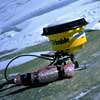|
Dave Mencin explains the ellipsoid/spheroid model:
"These two are related not just by vertical separation, but also tilt. Spheroids are approximate ellipsoids that were fit to the local area. But in the case of earlier Mount Everest surveys, the spheroid did not hold with the model on the Earth’s center of gravity. The last survey, done by an Indian surveyor named Gulatee in 1954, had a "fit" that threw the center of the earth off by some 700 meters. This whole problem is compounded by the fact that India, in particular, has a large deformation in the geoid (-106 m). This is most likely caused by some deep mantle process, but just exactly what is unknown at this time. "Also related to the above is all the factors from Gulatee,s measurement that give it an error bar of +/- 11 feet. Which brings our measurement closer together - the correction "should" be due entirely to the definition of "height above sea level" as Gulatee's survey was rock solid.
Corfield elaborates on the term geoid:
"In more practical terms, it means that a ball-bearing placed on this surface won't roll in any direction, i.e. there is no downhill (or uphill); or alternatively, you can think of it as a surface on which a spirit level's bubble is always exactly centered, or as a surface which a plumb line always intersects perpendicularly. For a surveyor out in the field, it is a very good approximation to say that his spirit level is always parallel to the geoid even if he is a little ways above or below it."
How Gulatee’s work compares with the survey done last spring
"It is a classic work," says Corfield, “and sets a high standard to follow. There have been two rounds of new technology since his day: laser ranging, and GPS. The former is still subject to the same uncertainties as theodolites (deflection of the vertical and atmospheric refraction). It is the latter (GPS) combined with a substantial body of work on geoid models that allows us to contemplate a revision that could aspire to be a worthy successor to Gulatee's work." As for the methodology the expedition employed last spring, Corfield describes the work like this: "Gulatee," said Charles Corfield, "used the Everest Spheroid/Geoid, and his best estimate in those coordinates was 8848 meters. Dave Mencin has compared the geoid used by Gulatee with a contemporary geoid model, and they differ by approximately. 10 meters, or about 30 feet, in the Everest region. This difference alone suggests that it is time to revisit the computations that determine the official height of the mountain. However, Gulatee also had to contend with refractive effects in the atmosphere on his optical equipment, a sloping snow surface on which to align his theodolite, and deviations of the vertical-- i.e. the tendency of mountains to tug on the spirit level. GPS of course is almost completely immune to these factors. "Our figures from this spring, which I will round to the nearest 10m for simplicity, are as follows: "Bishop Ledge, 8780 meters in WGS84 coordinates; which becomes 8810 meters after correcting to the WGS84 geoid, and would be 8820 meters in Gulatee coordinate system. "Now, our best guess is that the summit lies no higher than 20 meters above the ledge, and probably no more than 15 meters. Therefore, the contemporary height for the summit would be no more than 8830 meters above the (WGS84) geoid, which is a hair (or hare) less than 29,000', and would correspond to 8840 meters in Gulatee's coordinates."
— Peter Potterfield, Mountain Zone Staff
|
||||
[Everest '98] [More Climbing Stories] [MountainZone.com Home]
